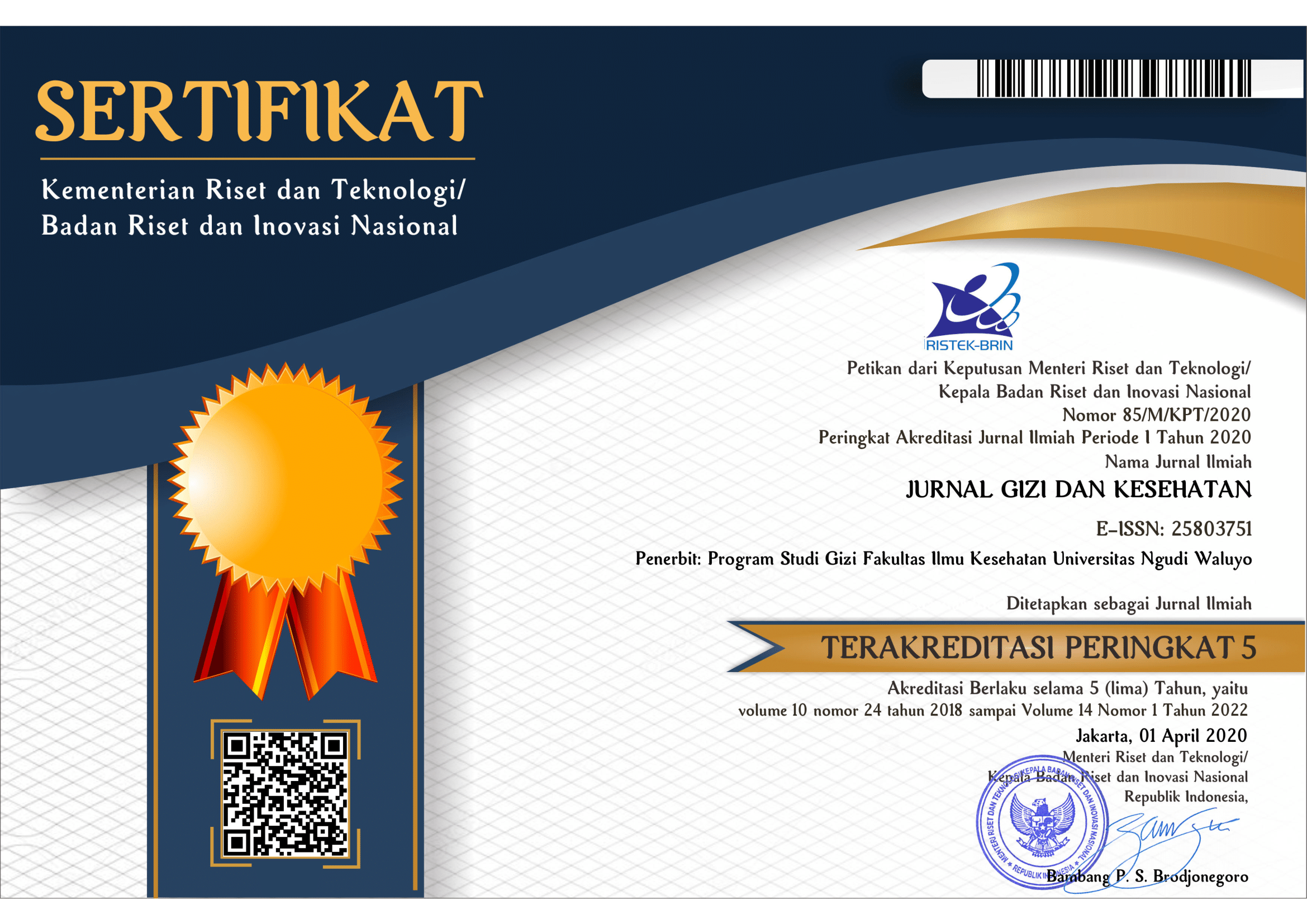Kadar MDA (Malondialdehyde) dan Aktivitas SOD (Superoxide Dismutase) pada Tikus Defisiensi Vitamin D dan Kalsium
Malondialdehyde (MDA) Levels and SOD (Superoxide Dismutase) Activity in Vitamin D and Calcium Deficiency Rat
DOI:
https://doi.org/10.35473/jgk.v17i1.732Abstract
Vitamin D and calcium deficiencies are often associated with increased oxidative stress. Oxidative stress conditions can cause cell damage and metabolic stress and induce degenerative diseases. Several parameters that are often used to measure oxidative stress are MDA (malondialdehyde) and SOD (superoxide dismutase) which can be found in blood or body tissue. This study aims to determine MDA levels and SOD activity in the livers of mice with vitamin D and calcium deficiency. This research used a pre-experimental design with a static group comparison design. A total of 12 male Wistar white rats (Rattus novergicus) were divided into two groups. The first group (K+) is a healthy control group without any treatment and the second group (K-) is a deficiency group given feed without vitamin D and calcium content (Modified AIN-93M (vitamin D and calcium depleted)). After 14 days of treatment, the MDA levels and SOD activity in the liver tissue were seen. MDA levels were measured using TBARS (Thiobarbituric Acid Reactive Substances) and SOD activity was measured using the Superoxide Dismutase (SOD) Activity Assay Kit. The results showed that MDA levels in the deficiency group (K-) were higher than in the control group (p<0.001) and SOD activity was lower than in the control group (p<0.001). MDA levels were higher and SOD activity was lower in the group of deficient mice (K-) compared to the group of healthy control mice (K+). Vitamin D and calcium deficiency conditions increase oxidative stress conditions in the liver of rat.
ABSTRAK
Defisiensi vitamin D dan kalsium sering dihubungkan dengan peningkatan stress oksidatif. Kondisi stres oksidatif dapat menyebabkan kerusakan sel dan stress metabolik dapat menginduksi penyakit degenerative. Beberapa parameter yang sering digunakan untuk mengukur stres oksidatif yaitu MDA (malondialdehyde) dan SOD (superoxide dismutase) yang bisa ditemukan di darah atau jaringan tubuh. Penelitian ini bertujuan untuk mengetahui kadar MDA dan aktivitas SOD pada organ hati tikus dengan defisiensi vitamin D dan kalsium. Penelitian ini menggunakan rancangan pra-eksperimental (pre-experimental) dengan design static group comparison. Sebanyak 12 ekor tikus putih (Rattus novergicus) jantan galur Wistar dibagi menjadi dua kelompok. Kelompok pertama (K+) yaitu kelompok kontrol sehat tanpa diberikan perlakuan apapun dan kelompok kedua (K-) yaitu kelompok defisiensi dengan diberikan pakan tanpa kandungan vitamin D dan kalsium (AIN-93M Termodifikasi (vitamin D and calcium depleted)). Setelah 14 hari perlakuan, dilihat kadar MDA dan aktivitas SOD di jaringan organ hati. Pengukuran kadar MDA menggunakan TBARS (Thiobarbituric acid reactive substances) dan pengukuran aktivitas SOD dengan menggunakan Superoxide Dismutase (SOD) Activity Assay Kit. Hasil penelitian menunjukkan kadar MDA pada kelompok defisiensi (K-) lebih tinggi dibandingkan kelompok kontrol (p< 0.001) dan aktivitas SOD lebih rendah dibandingkan kelompok kontrol (p<0.001). Kadar MDA lebih tinggi dan aktivitas SOD lebih rendah pada kelompok tikus defisieni (K-) dibandingkan kelompok tikus kontrol sehat (K+). Kondisi defisiensi vitamin D dan kalsium meningkatkan kondisi stres oksidatif pada organ hati tikus.
Downloads
References
Adelani, I.B. et al. (2020) ‘Dietary vitamin D ameliorates hepatic oxidative stress and inflammatory effects of diethylnitrosamine in rats’, Heliyon, 6(9), p. e04842. Available at: https://doi.org/10.1016/j.heliyon.2020.e04842.
Asghari, S., Hamedi-Shahraki, S. and Amirkhizi, F. (2021) ‘Vitamin D status and systemic redox biomarkers in adults with obesity’, Clinical Nutrition ESPEN, 45, pp. 292–298. Available at: https://doi.org/10.1016/j.clnesp.2021.07.032.
Avelar, T.M.T. et al. (2015) ‘Oxidative stress in the pathophysiology of metabolic syndrome: Which mechanisms are involved?’, Jornal Brasileiro de Patologia e Medicina Laboratorial, 51(4), pp. 231–239. Available at: https://doi.org/10.5935/1676-2444.20150039.
Banjare, J. et al. (2017) ‘Estimation of serum malondialdehyde as a marker of lipid peroxidation in medical students undergoing examination-induced psychological stress’, Journal of the Scientific Society, 44(3), p. 137. Available at: https://doi.org/10.4103/jss.jss_13_17.
Bannigida, D.M., Nayak, B.S. and Vijayaraghavan, R. (2020) ‘Insulin resistance and oxidative marker in women with PCOS’, Archives of Physiology and Biochemistry, 126(2), pp. 183–186. Available at: https://doi.org/10.1080/13813455.2018.1499120.
Berridge, M.J. (2017) ‘Vitamin D deficiency accelerates ageing and age-related diseases: a novel hypothesis’, Journal of Physiology, 595(22), pp. 6825–6836. Available at: https://doi.org/10.1113/JP274887.
Bertero, E. and Maack, C. (2018) ‘Calcium signaling and reactive oxygen species in Mitochondria’, Circulation Research, 122(10), pp. 1460–1478. Available at: https://doi.org/10.1161/CIRCRESAHA.118.310082.
Blumberg, J. (2004) ‘Use of biomarkers of oxidative stress in research studies’, Journal of Nutrition, 134(11), pp. 3188–3189.
Brock, K. et al. (2010) ‘Low vitamin D status is associated with physical inactivity, obesity and low vitamin D intake in a large US sample of healthy middle-aged men and women’, Journal of Steroid Biochemistry and Molecular Biology, 121(1–2), pp. 462–466. Available at: https://doi.org/10.1016/j.jsbmb.2010.03.091.
Chin, K.Y. et al. (2014) ‘Vitamin D status in Malaysian men and its associated factors’, Nutrients, 6(12), pp. 5419–5433. Available at: https://doi.org/10.3390/nu6125419.
Choi, M.J. and Jung, Y.J. (2017) ‘Effects of taurine and vitamin D on antioxidant enzyme activity and lipids profiles in rats fed diet deficient calcium’, Advances in Experimental Medicine and Biology, 975, pp. 1081–1092. Available at: https://doi.org/10.1007/978-94-024-1079-2_86.
Frederiks, W.M. and Bosch, K.S. (1997) ‘Localization of superoxide dismutase activity in rat tissues’, Free Radical Biology and Medicine, 22(1–2), pp. 241–248. Available at: https://doi.org/10.1016/S0891-5849(96)00328-0.
Fridovich, I. (1978) ‘The superoxide radical is an agent of oxygen toxicity; superoxide dismutase provide an important defense’, The Biology of Oxygen Radicals, 201, pp. 875–80.
Gemcioglu, E. et al. (2021) ‘Assessing Oxidative Stress by Thiol/Disulfide Homeostasis Among Vitamin D-Deficient Patients’, Cureus, 13(12), pp. 1–7.
Green, T.J. et al. (2008) ‘Vitamin D status and its association with parathyroid hormone concentrations in women of child-bearing age living in Jakarta and Kuala Lumpur’, European Journal of Clinical Nutrition, 62(3), pp. 373–378. Available at: https://doi.org/10.1038/sj.ejcn.1602696.
Halliwell, B. (2015) ‘Free Radicals and Other Reactive Species in Disease’, eLS, (Iii), pp. 1–9. Available at: https://doi.org/10.1002/9780470015902.a0002269.pub3.
Halliwell, B. and Chirico, S. (1993) ‘Lipid peroxidation: significance and its mechanism.’, The American journal of clinical nutrition, 57(February), pp. 715–725.
Hardisman (2021) Tanya Jawab Metodologi Penelitian Kesehatan. 1st edn. Yogyakarta: Gosyen Publishing.
Hauck, A.K. and Bernlohr, D.A. (2016) ‘Thematic review series: Lipotoxicity: Many roads to cell dysfunction and cell death: Oxidative stress and lipotoxicity’, Journal of Lipid Research, 57(11), pp. 1976–1986. Available at: https://doi.org/10.1194/jlr.R066597.
Holick, M.F. (2007) ‘Vitamin D deficiency’, N Engl J Med, 357(3), pp. 266–81. Available at: https://doi.org/10.1136/bmj.318.7193.1284a.
Holick, M.F. (2017) ‘The vitamin D deficiency pandemic: Approaches for diagnosis, treatment and prevention’, Reviews in Endocrine and Metabolic Disorders, 18(2), pp. 153–165. Available at: https://doi.org/10.1007/s11154-017-9424-1.
Keumala S, D. et al. (2014) ‘Occurrence of Vitamin D Deficiency among Women in North Sumatera, Indonesia’, Malaysian Journal of Nutrition, 20(1), pp. 63–70.
Khazai, N., And, S.E.J. and Tangpricha, V. (2008) ‘Calcium and Vitamin D: Skeletal and Extraskeletal Health Natasha’, Current Rheumatology Reports, 10(2), pp. 110–117.
Kregel, K.C. and Zhang, H.J. (2007) ‘An integrated view of oxidative stress in aging: Basic mechanisms, functional effects, and pathological considerations’, American Journal of Physiology - Regulatory Integrative and Comparative Physiology, 292(1), pp. 18–36. Available at: https://doi.org/10.1152/ajpregu.00327.2006.
Melguizo-Rodríguez, L. et al. (2021) ‘Role of vitamins in the metabolic syndrome’, The Metabolic Syndrome: Dietary Supplements and Food Ingredients, pp. 1–17. Available at: https://doi.org/10.1201/9781003329732-9.
Murdaca, G. et al. (2019) ‘Emerging role of vitamin D in autoimmune diseases: An update on evidence and therapeutic implications’, Autoimmunity Reviews, 18(9), p. 102350. Available at: https://doi.org/10.1016/j.autrev.2019.102350.
Palacios, C. and Gonzalez, L. (2014) ‘Is vitamin D deficiency a major global public health problem?’, Journal of Steroid Biochemistry and Molecular Biology, 144(PART A), pp. 138–145.
Pervaiz, S. et al. (2020) Redox signaling in the pathogenesis of human disease and the regulatory role of autophagy. 1st edn, International Review of Cell and Molecular Biology. 1st edn. Elsevier Inc. Available at: https://doi.org/10.1016/bs.ircmb.2020.03.002.
Sanz, R. et al. (2020) ‘Vitamin D-mitochondria cross-talk could modulate the signalling pathway involved in hypertension development: a translational integrative overview’, Clínica e Investigación en Arteriosclerosis (English Edition), 32(4), pp. 144–155. Available at: https://doi.org/10.1016/j.artere.2020.02.003.
Sarsour, E.H. et al. (2009) ‘Redox control of the cell cycle in health and disease’, Antioxidants and Redox Signaling, 11(12), pp. 2985–3011. Available at: https://doi.org/10.1089/ars.2009.2513.
Singh, P.K. et al. (2020) ‘Oleic Acid Prevents Isoprenaline-Induced Cardiac Injury: Effects on Cellular Oxidative Stress, Inflammation and Histopathological Alterations’, Cardiovascular Toxicology, 20(1), pp. 28–48. Available at: https://doi.org/10.1007/s12012-019-09531-y.
Sun, H. et al. (2022) ‘Circulating malondialdehyde level in patients with epilepsy: A meta-analysis’, Seizure : European Journal of Epilepsy, 99, pp. 113–119. Available at: https://doi.org/10.1016/j.seizure.2022.05.015.
Tsikas, D. (2017) ‘Assessment of lipid peroxidation by measuring malondialdehyde (MDA) and relatives in biological samples: Analytical and biological challenges’, Analytical Biochemistry, 524, pp. 13–30. Available at: https://doi.org/10.1016/j.ab.2016.10.021.
Untari, U. et al. (2023) ‘The Effect of Liprotide-Encapsulated Vitamin D3 on MDA and SOD in Rats Deficient Vitamin D and Calcium’, Journal of Biomedicine and Translational Research, 9(1), pp. 1–6. Available at: https://doi.org/10.14710/jbtr.v9i1.16289.
Wang, M. et al. (2013) ‘Calcium-deficiency assessment and biomarker identification by an integrated urinary metabonomics analysis’, BMC Medicine, 11(1), p. 86. Available at: https://doi.org/10.1186/1741-7015-11-86.
Wimalawansa, S.J. (2019) ‘Vitamin D Deficiency : E ff ects on Oxidative Stress , Epigenetics, Gene Regulation, and Aging’, Biology, 8(2), pp. 1–15.
Wu, C. et al. (2020) ‘Effects of dietary vitamin D3 on growth performance, antioxidant capacities and innate immune responses in juvenile black carp Mylopharyngodon piceus’, Fish Physiology and Biochemistry, 46(6), pp. 2243–2256. Available at: https://doi.org/10.1007/s10695-020-00876-8.









